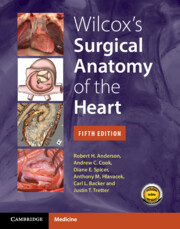Book contents
- Wilcox’s Surgical Anatomy of the Heart
- Wilcox’s Surgical Anatomy of the Heart
- Copyright page
- Contents
- Preface
- Acknowledgements
- Chapter 1 Surgical Approaches to the Heart
- Chapter 2 Development of the Heart
- Chapter 3 Anatomy of the Cardiac Chambers
- Chapter 4 Surgical Anatomy of the Valves of the Heart
- Chapter 5 Surgical Anatomy of the Coronary Circulation
- Chapter 6 Surgical Anatomy of Cardiac Conduction
- Chapter 7 Analytic Description of Congenitally Malformed Hearts
- 8 Lesions with Normal Segmental Connections
- 9 Lesions in Hearts with Abnormal Segmental Connections
- 10 Abnormalities of the Great Vessels
- Chapter 11 Positional Anomalies of the Heart
- Index
- References
Chapter 11 - Positional Anomalies of the Heart
Published online by Cambridge University Press: 10 April 2024
- Wilcox’s Surgical Anatomy of the Heart
- Wilcox’s Surgical Anatomy of the Heart
- Copyright page
- Contents
- Preface
- Acknowledgements
- Chapter 1 Surgical Approaches to the Heart
- Chapter 2 Development of the Heart
- Chapter 3 Anatomy of the Cardiac Chambers
- Chapter 4 Surgical Anatomy of the Valves of the Heart
- Chapter 5 Surgical Anatomy of the Coronary Circulation
- Chapter 6 Surgical Anatomy of Cardiac Conduction
- Chapter 7 Analytic Description of Congenitally Malformed Hearts
- 8 Lesions with Normal Segmental Connections
- 9 Lesions in Hearts with Abnormal Segmental Connections
- 10 Abnormalities of the Great Vessels
- Chapter 11 Positional Anomalies of the Heart
- Index
- References
Summary
The surgical problems posed by cardiac malformations may be considerably increased when the heart itself is in an abnormal position. This is, in part, due to the unusual anatomical perspective presented to the surgeon because of the malposition, and also to the abnormal locations of the cardiac chambers, which may necessitate approaches other than those already discussed. Cardiac malposition in itself, nonetheless, does not constitute a diagnosis. Any normal or abnormal segmental combination can be found in a heart which itself is abnormally located. The heart may be normal, despite its abnormal location, but extremely complex anomalies are frequently present. Consequently, the very presence of an abnormal cardiac position emphasizes the need for a full and detailed segmental analysis of the heart. All the rules enunciated in Chapter 7 apply should the heart not be in its anticipated position.
- Type
- Chapter
- Information
- Wilcox's Surgical Anatomy of the Heart , pp. 465 - 477Publisher: Cambridge University PressPrint publication year: 2024

